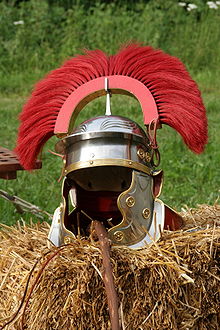Crista (helmet)

The crista ( lat .: Groin, comb) was a comb-like helmet plume of Roman legionaries, mostly made of colored horsehair , partly also made of feathers . It served as a helmet ornament for teams and ran from front to back over the helmet. With centurions they were a rank mark and were worn across the helmet to distinguish them ( crista transversa ). The crista was detachably attached to the helmet. For this purpose, different mounts were used at different times and with different types of helmets (→ Weisenau (helmet) ). In the late Republican and early Imperial times, a tail-like helmet plume was attached to a central spout on older Roman helmets (→ Montefortino (helmet) ). The crista was either put with a metal foot into a loop or grommet attached to the middle of the helmet and the ends were tied at the front and back or, in the case of centurions, at the side in eyelets. On some helmets there are no central mountings, but instead protruding rivets on the helmet edge. It is assumed here that cristae were used, in which the horsehair was fixed on a leather cord that was stretched flat over the helmet between the rivets.
Pictorial representations of battles indicate that helmet bushes were only worn by centurions in combat, so that the officers could easily be recognized and found by their soldiers in the fray. However, it is not possible to make a clear statement about this, as the representations often deviate from reality out of artistic interest. Teams probably only put on the crista on special occasions such as parades or ceremonies. From the end of the first to the middle of the second century AD, mounts for helmet bushes largely disappeared from team helmets. Apparently they were never used in the cavalry.
literature
- Yearbook of the Roman-Germanic Central Museum Mainz. Volume 41, Part 2, 1996, p. 510.
- Marcus Junkelmann, Hermann Born: Roman helmets. Verlag Sammlung Guttmann bei Philipp von Zabern, Mainz 2000, ISBN 3-8053-1670-4 , p.